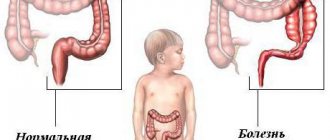Cytomegalovirus infection in newborns: diagnosis and treatment
Cytomegalovirus infection (CMVI) is a textbook latent infection. Cytomegalovirus (CMV) contains DNA, has the ability to reactivate, has a tropism for glandular tissue, where it persists, and has a cytopathic effect, as a result of which giant cells similar to an “owl’s eye” are formed.
In Western Europe (France, Germany, Spain), from 50 to 70% of the total population are infected with CMV. There are no exact statistical data on the frequency of infection in Russia or even in Moscow.
A great impetus for the study of CMVI was given by the successes of transplantology. There is good reason to believe that the cause of graft rejection is activation of CMV infection. The frequency of infection (the presence of antibodies of the immunoglobulin (Ig) G class to CMV) with CMV depends on socio-economic conditions, the degree of damage to the immune system, etc. CMV belongs to the category of “weak antigens”. The study of these viruses and their effects, for example, on the vascular endothelium and a number of other organs, except the salivary glands, continues.
We have conducted many years of systematic research (I.V. Orlovskaya, A.V. Aleksandrovsky, V.V. Zubkov) on various aspects of the development of this infection. It was found that this is a typical socially significant infection. Data indicate that in Moscow over the past 15 years, CMVI has undergone significant evolution.
Thus, from 1988 to 1993, IgG antibodies to CMV were detected in mothers and their newborn sick children only in 40–50% of cases.
A dependence on the social class of patients and a number of additional factors was revealed: most often (from 86 to 96% of cases) the infection is detected in patients who have undergone kidney transplants, homosexuals and patients with AIDS (Western Europe, USA).
According to our data obtained on the basis of seroepidemiological studies conducted in 1995–1999. and in 2000–2002. In women of reproductive age who gave birth to children with intrauterine infection, the frequency of circulating antibodies to CMV of the IgG class reaches a high level (90% of the total number of subjects) and does not tend to decrease.
This indicates the absence and ineffectiveness of control of sexually transmitted infections in women, including CMV. It has been established that in 60% of cases, patients simultaneously have specific antibodies to several perinatal pathogens. The most common are herpes simplex virus (HSV), CMV, chlamydia and ureaplasma. The proportion of mixed infections is significant and continues to grow. It is difficult to identify the leading pathogen; this requires additional research.
CMV is an infection of the fetus. This infection is especially dangerous for pregnant women. Manifestations of CMV infection are mostly subtle; especially often in pregnant women, it occurs in the form of an acute respiratory viral infection.
After puberty, CMV spreads mainly through sexual contact. In pregnant women, it often appears “under the guise” of another disease. Therefore, timely diagnosis of the disease is difficult. Although not specifically manifested in women, in the fetus CMV causes congenital disorders of the central nervous system, malformations of the heart and kidneys.
It has been proven that CMV causes polyhydramnios and at the same time the development of hydrops fetalis (A. Breinl, Lebmanu), threatened and spontaneous abortion, and fetoplacental insufficiency. Detection of CMV in stillbirths varies from 9 to 33% (Germany, France). Infection is difficult to detect due to poor diagnostics. All manifestations of CMV in women and the fetus develop against the background of immunodeficiency.
One of the main ways of spreading the infection is through sexual transmission. This is evidenced by the simultaneous presence of antibodies to HSV and CMV in patients.
A large number of pregnant women, especially in the last trimesters of pregnancy, become infected through orogenital contact (up to 20% or more).
CMV infection can occur after transfusion of infected blood. In Western Europe and the USA, 15–70% of blood samples contain CMV. In addition, CMV can enter the body during transplantation of infected kidneys, bone marrow, heart and other organs. In 20% of cases, the cause of the rejection reaction is activation of CMV (Germany, USA). The imperfection of CMV diagnostics often does not allow us to prove the significance of viral aggression in the formation of a particular pathological process.
As mentioned above, all manifestations of CMV infection in women and the fetus develop against the background of immunodeficiency. The results of many years of research conducted at the Scientific Center for Gynecology and Pregnancy of the Russian Academy of Medical Sciences have shown that one of the leading causes of intrauterine infection is the state of immunosuppression in the mother during pregnancy. This is especially evident in women with hyperandrogenism, myasthenia, lymphogranulomatosis, etc., who receive steroid therapy before and during pregnancy.
CMV infection is endemic in all human populations. The routes of infection of a fetus, newborn, and adult are different.
Infection of the fetus can be carried out through the hematogenous-transplacental route, especially if there is a primary infection in the woman and if the placenta is damaged with a violation of its barrier function. In 10–15% of fetal cases, signs of CMV infection appear immediately after birth. The hematogenous-transplacental route of infection of the fetus with CMV is the main one.
Ascending infection occurs when CMV is present in cervical and vaginal secretions, as well as through infected amniotic fluid.
Up to 5–7% of newborns become infected intrapartum, both through direct contact with infected material and through aspiration of amniotic fluid containing CMV.
In the postnatal period, a newborn becomes infected in 30% of cases (WHO data) from maternal secretions containing the virus: saliva, urine, genital discharge, breast milk, blood. Our studies have shown that CMV antigen can also be detected in the cerebrospinal fluid, especially if the child has a generalized form of infection with cerebral damage.
According to Clive Smeet, CMV spreads hematogenously to various organs, including the kidneys, liver, spleen, heart, brain, retina, esophagus, inner ear, lungs, and intestines.
During the period of viremia, CMV DNA can be detected in monocytes, lymphocytes, and neutrophils. White blood cells play an important role in the dissemination of the virus throughout the body. CMV is more susceptible to polynuclear phagocytes than to mononuclear cells. The fact of damage to the endothelium of blood vessels, heart, and ventricles of the brain can be considered proven.
CMV can occur in the form of a primary (acute) infection with the appearance and growth of specific antibodies to CMV of the IgM class, and subsequently IgG. This form of infection is characterized by the presence of a virus-specific antigen in the blood, urine and cerebrospinal fluid. Primary infection in pregnant women is especially dangerous. In this case, vertical transmission (transplacental route) of the virus to the fetus occurs very easily.
This infection can cause serious changes in the fetus: microcephaly, hepatosplenomegaly, thrombocytopenia, prolonged jaundice, and less commonly, hearing loss, mental retardation, etc. In this situation, the fetus may experience viral interstitial pneumonitis, retinitis, encephalitis, and gastrointestinal diseases.
With earlier infection with CMV, malformations of the gastrointestinal tract may occur. Infection of the fetus during primary infection in all cases occurs in the absence of specific IgG antibodies in the pregnant woman, which is the cause of severe damage to the fetus.
Pregnant women are often infected with the primary form of CMV through orogenital contact. This form of infection poses the greatest danger to a pregnant woman and fetus, as it develops against the background of a complete absence of specific antibodies.
Reactivation refers to a form of CMV infection that was previously latent and asymptomatic. Reactivation of the virus occurs under the influence of steroid hormone therapy in pregnant women (fetuses), immunocompromised patients (transplant recipients, people with AIDS). Thus, in newborns born to women for whom reproductive technologies were used, as well as in the women themselves, we identified anti-cytomegalovirus IgG antibodies in 100% of cases.
When CMV is reactivated in a pregnant woman, there may be an increase in antibody titers of both the IgG and IgM classes to CMV. However, in a number of patients, the new appearance of IgM antibodies does not occur due to the formation of a secondary immunological response, characterized by overproduction of specific IgG antibodies. This explains the fact that in this case both a healthy child and a newborn with serious manifestations of CMV infection can be born.
CMV infection (primary) can develop into chronic or latent forms, which can be reactivated.
Reinfection - infection of a patient with a new exogenous virus - can be accompanied by immunological changes, a repeated increase in the titer of specific IgM, and subsequently IgG, or (less often) only an increase in the titer of specific IgG antibodies. There are no serological tests to help distinguish primary from secondary infection in such situations.
In patients with immunodeficiency, AIDS and in newborns, antibodies may not be detected during reactivation. In their diagnostic process, several methods must be used simultaneously.
The simultaneous presence of IgG antibodies and a positive test (polymerase chain reaction - PCR) is sufficient to confirm the clinical diagnosis.
In terms of clinical manifestations, congenital CMV and herpetic infections have both similar features and significant differences. Both diseases tend to become chronic.
The frequency of intrauterine damage to various organs and systems of CMV, according to various authors, is not the same. According to updated pathohistological data, the most frequently observed (in order of frequency of detection) are brain lesions (meningoencephalitis, lesions of the cerebral ventricles, calcifications, “calcification” of cerebral vessels). All these morphological changes are accompanied by various neurological manifestations: from mild cerebral changes to severe convulsive, hypertensive-hydrocephalic syndromes, etc.
One of the common manifestations of CMV infection is blockage of the cerebrospinal fluid pathways (up to 7% of perinatal brain damage of viral etiology). Another “point of application” of CMV is often the choroid plexus with subsequent formation of cysts.
Our observations have shown that mineralization vasculopathy (“calcification” - in the terminology of foreign authors) of cerebral vessels, accompanying CMV infection, can be the cause of convulsive syndrome in a newborn. In this case, convulsive syndrome occurs from the first hours after birth and lasts up to 5 days or more. This condition requires careful specific treatment with cytotect, anticonvulsants, etc. Changes in cerebral vessels caused by CMV require further study.
In these cases, it is necessary to exclude herpetic infection of the newborn child. Intrauterine hydrocephalus in the fetus is often associated with CMV (Germany, Austria).
A fairly common manifestation of CMV infection is pneumonia. Among the total number of pneumonias (more than 1/3 of all patients admitted to the neonatal pathology department of the Scientific Center for Aging and Pediatrics), in approximately 10% of cases the etiological factor is CMV, which was confirmed by assessing the epidemiological history of the mother: the presence of endocervicitis, colpitis, immunosuppressive factors, carriage of HSV and CMV, as well as the mandatory presence of IgG and IgM and (less often) a positive PCR in the newborn.
It should be noted that radiographically, focal inflammatory infiltrates and, less commonly, segmental shadows were detected. Hematological examination revealed leukocytosis with a neutrophilic shift to the left, and less commonly, thrombocytopenia. There is no doubt that secondary bacterial flora is involved in the genesis of these pneumonias; activation of the latter occurs later. In this case, infection of a newborn occurs both by aspiration (more often) and hematogenously. Secondary immunodeficiency in these cases leads to a longer course of the disease and requires simultaneous immunotherapy.
As J. Frank and H. Fridman point out, CMV in the form of pneumonia often leads to death in patients with AIDS, in patients after kidney, bone marrow, and heart transplants. The cause of severe pneumonia with CMV infection is suppression of immune reactions.
Often manifestations of CMV infection in newborns are hepatosplenomegaly and prolonged jaundice (up to 32%). Over the past 5 years, the number of patients with hyperbilirubinemia has increased, with a slight change in transaminase levels. This fact requires further study of the role of CMV.
We observed thrombocytopenia (up to 2–3%) mainly against the background of generalized forms of infection.
In 30% of cases, CMV infection can occur without local changes and manifest only by a deterioration in the general condition of patients and the presence of specific IgM antibodies. This form in some cases occurs easily, but always requires the exclusion of generalization of the process and immunotherapy.
CMV infection can cause: myocarditis, cardiomegaly, myocardial thickening, enlarged atrium, hydropericardium (up to 15%), as well as fetal hydrops.
In some cases, late lesions may also occur, which are registered only at 6–7 months of life: blindness, deafness, developmental delay, etc.
Diagnosis of this infection is complex and must be carried out taking into account its clinical manifestations.
- Assessment of the mother's epidemiological history (virus carriage), the presence of endocervicitis, adnexitis, colpitis, the presence of possible immunosuppressive effects on her and the fetus, examination of the patient.
- Taking into account the relevant clinical picture of the child: the presence of calcifications in the brain, cerebral vasculopathy, ventriculomegaly, encephalitis, as well as the detection of pneumonia, hepatosplenomegaly, prolonged hyperbilirubinemia, etc.
- Echoencephalography and ultrasound of internal organs.
- Determination of IgM and IgG class antibodies to CMV (enzyme immunoassay method - ELISA). The classical method using detection of an increase of 4 or more times specific IgG antibodies at the beginning and after 12–14 days is not used in newborns, although in adults it is the most reliable and accurate. In pregnant women, this serological method can be used. The newborn's immune system is not able to synthesize IgG antibodies; the latter pass transplacentally from mother to fetus.
- Detection of virus-specific antigens (parts of viruses) in cell culture is not used even for scientific purposes due to the high cost of the technique. Virus-specific antigen can be detected using the rapid immunofluorescence method; the latter is accurate, but unfortunately has not been used much in recent years.
Biotechnological methods are widely used: DNA hybridization and especially PCR. However, hybridization technology requires improvement, the availability of high-quality test systems and qualified laboratory technicians.
The PCR method, unfortunately, did not live up to the hopes placed on it. According to our data, the diagnosis can be confirmed by this method in no more than 50% of cases. Although abroad (Germany), many authors believe that a positive PCR and the presence of specific IgG antibodies are sufficient for a final diagnosis.
In all cases, when CMV antigen is detected in the urine, blood, or cerebrospinal fluid of a newborn, including positive PCR, it is necessary to confirm infection by identifying specific antiviral antibodies (IgG and IgM).
It should be mentioned that determining the presence of IgM-specific antibodies in the blood is the most reliable and fastest diagnostic method.
- Electron microscopy (EM) and immunohistology are used to detect antigen.
- The final interpretation of immunovirological results should be carried out with a simultaneous assessment of the mother's epidemiological history and possible immunosuppressive effects on her, especially when using reproductive technologies, taking into account the clinical manifestations of infection in the child.
The results of recent studies to elucidate the protective role of specific antiviral IgG to CMV antigens transmitted transplacentally from mother to fetus are of great scientific and practical importance.
Research carried out simultaneously in the laboratories of three institutes (NTsAGiP, Research Institute of Viral Preparations named after O. G. Andzhaparidze, State Research Institute of Biological Instrumentation) made it possible to draw the following scientific and practical conclusions.
- The development of intrauterine infection is based on immunosuppressive factors that affect the condition of the mother, fetus and newborn - the development of secondary immunodeficiency states in them. A unique argument in favor of the protective role of specific antiviral immunoglobulins is the fact that sick newborns born to mothers with the primary form of genital herpes (in the absence of antibodies) become infected 10 times more often. In 86% of cases, the infectious process occurs in a severe generalized form (with brain damage, pneumonia, etc.) and often ends in death.
It has been established that in 12% of cases, specific antiviral antibodies from a sick mother are not completely transferred to the newborn. Obviously, the reason for this phenomenon is a dysfunction of the placenta due to the development of an infectious process in it.
The role of suppression of immunological factors in the genesis of CMV reactivation and the occurrence of infection in newborns has been convincingly demonstrated.
Deficiency of antiviral IgG in the fetus and newborn leads to dissemination of the virus, the development of a generalized form of infection and severe damage to the brain, lungs, adrenal glands, etc.
Damage to the cellular immunity is noted; at the same time, the real possibility of their compensation decreases. A deficiency of cells belonging to a subpopulation of T cells that have cytotoxic activity against cells infected with viruses was revealed.
- In-depth studies of antiviral immunity have made it possible to identify a group of newborns suffering from intrauterine infection with “transient immunosuppressive conditions”, in the treatment of which drugs that affect the humoral component of immunity should be used.
- Violations in the humoral immunity are compensated by intravenous administration of immunoglobulin preparations. A special technology for their use has been developed. For patients with intrauterine viral infections, these drugs are a means of both replacement and specific therapy due to the content of antiviral antibodies in them. There is compelling evidence of their positive role. The use of immunoglobulins not only improves the condition of patients, but also increases the level of IgG in their blood. Due to the presence of antibodies of varying specificity in immunoglobulin preparations, their simultaneous administration with Zovirax and antibiotics ensures their synergistic effect.
This makes it possible to create the necessary component of “therapeutic technology”—immunotherapy.
Methods of treatment for CMV: chemotherapy (ganciclovir, foscarnet), interferon therapy (there is no reliable information about the effect on CMV) and immunotherapy with specific anti-cytomegalovirus immunoglobulin (cytotect).
Ganciclovir (cymevene) is an antiviral drug similar to acyclovir that affects all types of herpes viruses. Ganciclovir is 50 times more effective than acyclovir against CMV.
The drug was synthesized in 1982. It inhibits viral replication due to competitive inhibition of viral DNA polymerase and disruption of DNA chain elongation. Ganciclovir is excreted from the body through the kidneys. According to virological studies, the use of ganciclovir leads to suppression of the virus in 87% of patients, and the disappearance of CMV in the blood and urine is noted. Ganciclovir has been used primarily in the United States for patients with retinitis, a pneumonia that develops in patients with AIDS; in recipients of bone marrow, kidneys, as well as in persons with cytomegalovirus colitis. The drug is used at a dose of 10–20 mg/kg per week intravenously. In all cases, its clinical and virological effectiveness was proven.
After treatment with ganciclovir, however, complications such as neutropenia and thrombocytopenia were also observed. For this reason, we abandoned the use of ganciclovir.
Thus, it can be noted that chemotherapy for CMV disease is only taking its first steps. Further research is needed in this direction.
Foscarnet, used in patients with CMV pneumonia, is nephrotoxic. The search for effective and safe antiviral drugs continues.
Currently, the only effective method of therapy and emergency prevention of CMV in newborns is the use of immunoglobulin for intravenous infusions containing IgG antibodies to CMV.
There are strong scientific arguments in favor of this treatment approach. Firstly, there is extensive scientific and practical evidence of the effectiveness of the use of immunoglobulins for infections; secondly, there is no doubt about the need to correct the humoral component of immunity, especially in case of secondary immunodeficiencies. Thus, in case of CMV infection, immunoglobulins are a means of both immunoreplacement and etiotropic therapy. Thirdly, in recent years, the modulating effect of immunoglobulins when administered intravenously on the cellular component of immunity has been proven. Fourthly, activation of CMV infection always occurs against the background of immunodeficiency. The introduction of anticytomegalovirus immunoglobulins affects not only the etiological factor, but also makes it possible to influence various pathogenetic links of the disease.
The cellular immune response in patients infected with CMV has been shown to “recognize” at least one “very early” viral replication phase protein on the surface of the infected cell. This leads to the destruction of the infected cell by virus-specific cytotoxic T lymphocytes. In patients with immunodeficiency, this is not possible, since they do not have virus-specific cytotoxic T lymphocytes, or their number is insufficient. CMV neutralizing antibodies are in this case the only immunological components that prevent infection of the cell.
The mechanisms of action of immunoglobulins and synthetic virusostatics differ, since the latter cannot penetrate the cell. The antiviral effect develops outside the cell. By binding to glycoproteins on the surface of the virus, immunoglobulins prevent infection of other host cells. Both the free virus and the virus during its exit from the infected cell after replication can be neutralized. Free, neutralized viruses are excreted by the kidneys. If human immunoglobulin preparations are used for the treatment and prevention of CMV infection in immunosuppressed patients, no significant side effects occur, unlike therapy with viral agents.
One of the drugs used to treat serious forms of CMV infection in pregnant women and newborns is Cytotect. With the beginning of its use, the development of new methods for diagnosing this infection has intensified.
Cytotect is a hyperimmune immunoglobulin for intravenous infusion, containing 10 times more antibodies to CMV than conventional immunoglobulins. The drug is prepared from the blood of specially selected donors who have a high titer of anticytomegalovirus antibodies. 1 ml of cytotect contains at least 50 units of antibodies against CMV (units of the reference preparation of the Paul Ehrlich Institute). Immunoglobulin complies with European quality standards. Antibody levels are monitored by the German Federal Office for Vaccines and Serums (Paul Ehrlich Institut). At the same time, the drug contains an increased titer of antibodies to the Epstein-Barr virus antigens and to the HSV antigens of the 1st and 2nd types. In addition, Cytotect includes a wide range of antibodies to microbial pathogens - perinatal pathogens that cause serious infections in newborns and women in the postpartum period. These antibodies enhance the opsonization of microorganisms and have a distribution of IgG subclasses close to the physiological norm (IgGI - IgGIV).
The production of Cytotect is controlled in accordance with standards developed by the Paul Ehrlich Institute. Plasma collection is carried out after careful selection and testing of donors.
In addition, the entire plasma pool is under control. Multi-stage preparation and safety testing of cytotect eliminates the transmission of hepatitis and other infections, including those that have not yet been identified.
We conducted a clinical and immunological study of cytotect (N. I. Kudashov, O. V. Orlovskaya) in 56 patients with CMV infection. The diagnosis was confirmed in all cases by identifying anticytomegalovirus IgM in the patient.
At the same time, in the drugs administered to children, the presence of not only IgG antibodies to CMV, but also to HSV was determined. It was found that all series of drugs used contained specific antibodies to CMV and HSV type 1 antigens, while there were 2 times less antibodies to HSV type 2. It has been convincingly proven that Cytotect, in combination with traditional therapy, has a pronounced clinical and immunological effect. There was not only an improvement in the general condition of the patients: after 7–8 days, IgM disappeared from the patients’ blood, in addition, the content of anticytomegalovirus IgG in the blood increased significantly, and at the same time the content of antiherpetic IgG also increased. Thus, Cytotect is practically the only drug that is effective in the fight against CMV infection.
Indications for the use of Cytotect in early pregnancy:
- primary infection in a pregnant woman: circulation of antibodies to CMV of the IgM class in the blood;
- high probability of transmission of the virus to the fetus. Doses: at the 28th week - 2 ml/kg of body weight, at the 31st week - 1 ml/kg;
- in pregnant women who are carriers of antibodies to CMV of the IgG class with multiple perinatal losses, especially when combined with conditions accompanied by immunosuppression (hyperandrogenism, myasthenia, the use of reproductive technologies).
Cytotect is administered immediately after birth to the mother and child in the following cases:
- with primary (acute) CMV infection in the mother (circulation of IgM antibodies in the blood) due to the high probability of transmission of the virus to the fetus;
- with relapse of infection (presence of IgG antibodies + symptoms of infection) at the end of pregnancy;
- mother with the presence of anti-cytomegalovirus IgG antibodies and her child (6–7 months) if their antibody titer increases during observation.
Doses of Cytotect for the prevention and treatment of CMV infection for newborns are 2–4 ml/kg body weight; in the presence of encephalitis and serious neurotic changes, the administration is repeated many times.
For mothers with therapeutic purposes, the following cytotect treatment regimens are used:
- in mild cases - at a dose of 2 ml/kg body weight, cytotect transfusion can be repeated after 4 days depending on the clinical picture;
- in severe cases - at a dose of 4 ml/kg body weight, the transfusion of the drug can be repeated after 4 days, if the condition worsens, repeated repeated administration of the drug is possible.
For prophylactic purposes - at a dose of 1 ml/kg body weight. The drug is administered only intravenously, by drip (20 drops per 1 minute).
Doses of Cytotect for the prevention and treatment of CMV infection in newborns are 2–4 ml/kg body weight.
Antibiotic therapy is a permanent component of the treatment of CMV infection in newborns. Etiologically, almost all infectious diseases in newborns are caused by mixed viral-bacterial flora. With CMV infection, especially in the presence of pneumonia, activation of the secondary bacterial flora occurs very quickly - from the first days. The choice of antibacterial drugs is made empirically and is based on extensive experience and knowledge of the range of possible pathogens and the characteristics of the action of the antibiotic. For empirical starting therapy, it is advisable to choose an antibiotic with a wide spectrum of bactericidal action; in case of a generalized form of infection, combined antibacterial therapy with drugs that are active against possible “perinatal pathogens” in this case is used.
One of the most commonly used antibiotics in recent years is sulperazone. It is a combination of cefoperazone with the β-lactamase inhibitor sulbactam (3rd generation cephalosporins). Sulperazone is used intravenously (in the first 3–4 days) and intramuscularly twice a day at a dose of 80–100 mg/kg body weight; the course of therapy is from 8 to 14 days, on average - 10 days.
To enhance the gram-negative effect of sulperazone, an aminoglycoside, netromycin, is usually used. The drug was prescribed at the rate of 7 mg/kg body weight per day; course of therapy - no more than 7 days. Immunoglobulins for intravenous infusion and antibiotics (sulperazone + netromycin) are included in the standard of therapy. They are effective and significantly reduce the length of a child’s stay in the hospital (up to 10–12 days). In addition, it should be noted that there were no hospital-acquired infections, relapses, or cases of illness after discharge at home.
N. I. Kudashov , Doctor of Medical Sciences, Professor of NCAGiP, Moscow
Treatment methods for cytomegalovirus in children and adults
Cytomegalovirus infection belongs to the herpesvirus family. The disease is latent in healthy people, but is very dangerous for patients with immunodeficiency (HIV-infected people taking immunosuppressants after organ and tissue transplantation). Congenital cytomegalovirus infection can lead to serious pathologies and even death. Once infected, the virus remains in the body throughout life and is capable of reactivation at any time, which can cause the development of mucoepidermoid carcinoma and other malignancies. This is why it is so important to take a timely blood test for antibodies to cytomegalovirus during pregnancy.









